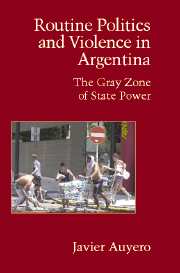Book contents
Appendix: Modeling the Looting Dynamics
Published online by Cambridge University Press: 05 June 2012
Summary
Based on a thorough reading of three national newspapers with different political leanings – from left to right; Página12, La Nación, and Clarín, and the main local newspapers of the ten provinces where lootings occurred: El Ciudadano, La Voz del Interior, La Mañana del Sur, Rio Negro, Cronica-Chubut, La Gaceta, El Litoral, El Liberal, Los Andes, and El Sol, we constructed a dataset with all the reported looting episodes. Since all the lootings took place during one week, we were able to read every single print and on-line edition of the thirteen newspapers for the week under scrutiny, thus providing an exhaustive dataset that avoids the problems related to sampling techniques (Earl et al. 2004:68).
As said before, for the purposes of data collection, a looting episode was defined as the activity of two or more persons either (a) forcibly seizing objects over restraint or resistance or (b) attempting to seize objects but effectively meeting with restraint or resistance. Some groups gathered in front of markets publicly demanding food without attempting to force entrance. We labeled these episodes “claims for food” and considered them to be conceptually different from looting episodes that, whether successful or not, involved violent confrontation. We found and coded 289 riot episodes, representing every looting, attempted looting, or claim for food reported by the Argentine press to have happened the week of December 14–22 (episodes in the federal capital were excluded from our dataset).
- Type
- Chapter
- Information
- Routine Politics and Violence in ArgentinaThe Gray Zone of State Power, pp. 159 - 166Publisher: Cambridge University PressPrint publication year: 2007

